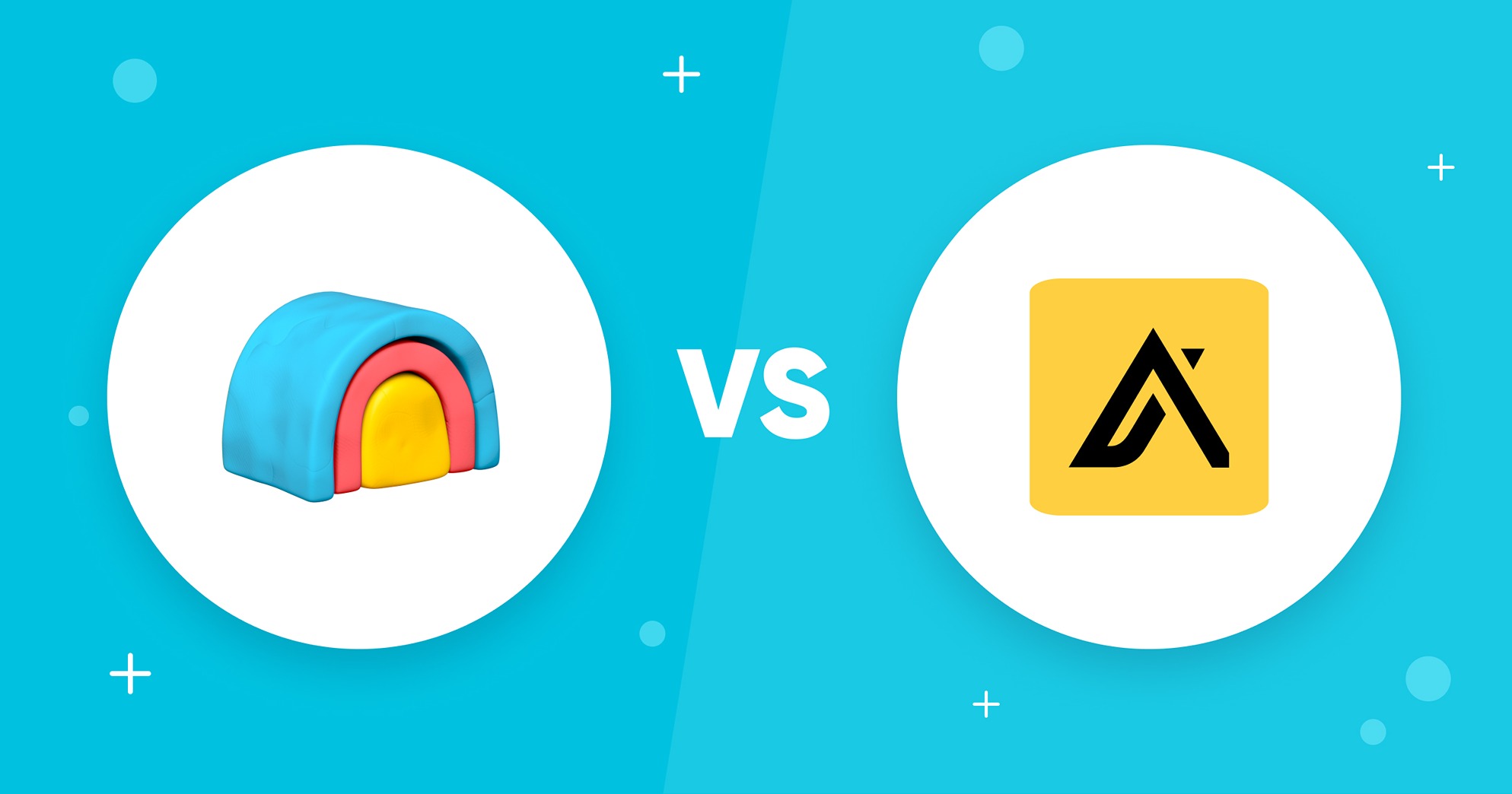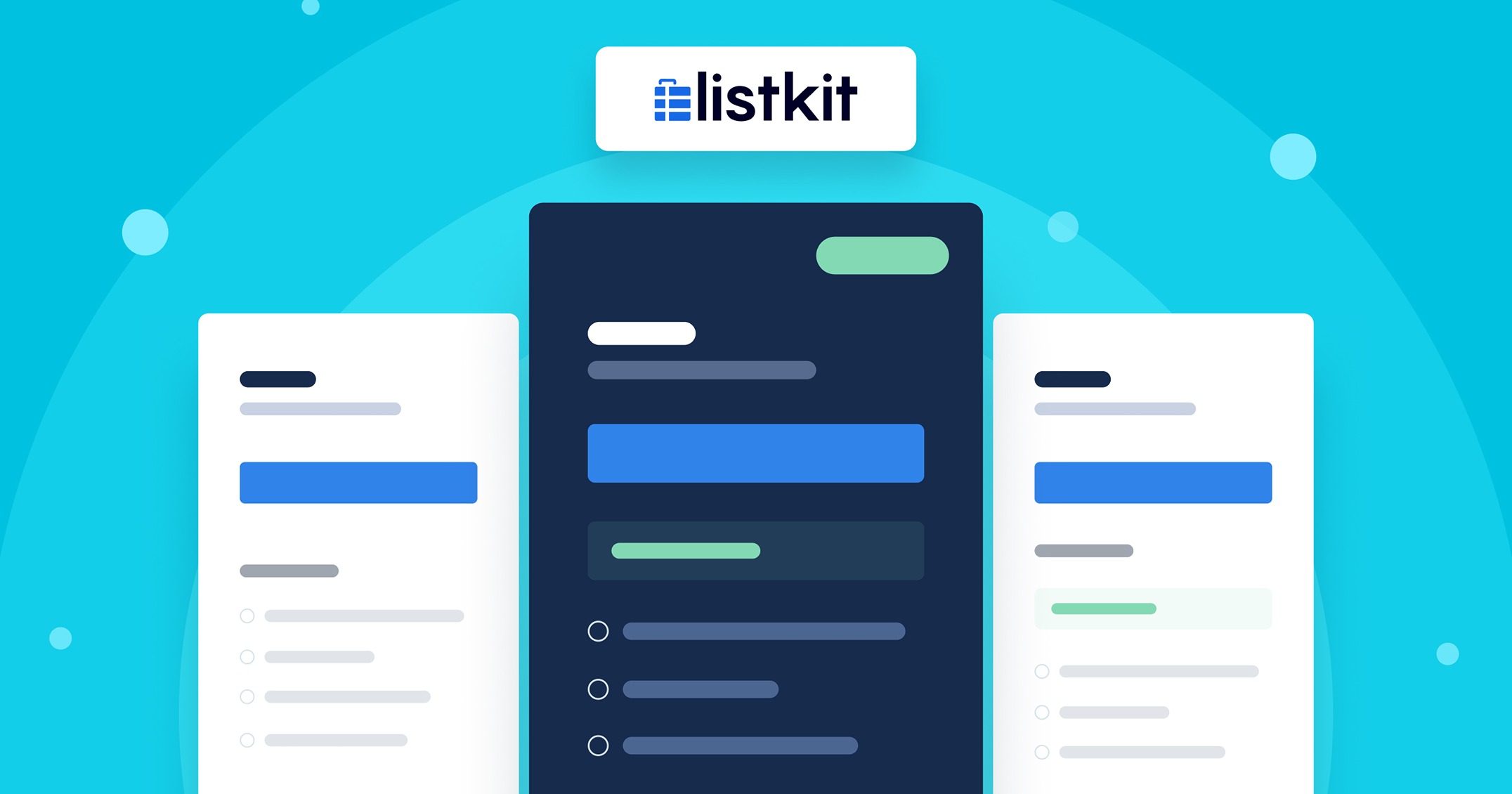This article will cover everything you need to know about cold calling vs. cold emailing. After reading, you’ll know which to use. More specifically, we’ll talk about the following:
- The basics of cold calling and cold emailing
- How do you decide between cold calling and cold emailing
- Essential tools for cold outreach
- Frequently asked questions
Let’s get started.
Cold Calling vs. Cold Emailing: The Basics
This section will define and cover the basics of cold calling and emailing. We’ll address when to use them and their pros and cons.
What is Cold Calling
Cold calling is a sales telemarketing strategy that uses telephonic communication to sell products and services to targeted prospects. These prospects have never interacted with the business calling on the telephone, and that’s why it’s called “cold.”
Generally speaking, cold calling is conducted over the phone. However, salespeople who go door-to-door can also do it in person. Cold calling is also referred to as “outbound calling.”
Cold calling has progressed over the years and has become more efficient thanks to technological advancements. Sales autodialers allow you to schedule and automate calls to save time and effort.
Lead generation doesn’t have to be all that painful. With UpLead, you can easily connect with high-quality prospects and leads to grow your company.

When to Use Cold Calling
When It’s a Personal Matter: Cold calling is ideal for discussing a personal matter with a prospect. Communicating over the phone lets you modulate the tone of your voice to match theirs.
When You Need an Immediate Response: If you need a quick response, consider using cold calling as an outreach method. A phone call is immediate, and your targeted prospects will either pick up or they won’t. You don’t have to worry about a spam folder.
When You Want to Uncover Roadblocks and Objections: Since calling on the phone is immediate and personal, cold calling is ideal for finding information about prospects. You can identify their roadblocks and objections to your products or services.
Pros & Cons of Cold Calling
Cold calling has pros and cons. The top ones are listed below.
Pros
- Reach new customers: If someone isn’t aware of your brand and its products and services, it’s doubtful they’ll ever become customers. Cold calling reaches out to these people who need your solution but don’t know it yet.
- Fast response times: Cold calling has shorter response times than other channels, such as email. You usually only need one call to pitch a product or service to a prospect. With a phone call, you get feedback straight away. Here are the best times for cold calling.
- More personal: Cold calling allows you to connect emotionally with your prospects. You can hear your prospect’s tone of voice and adjust your approach on the go. This isn’t possible with other forms of communication.
- Uncovers roadblocks and objections quickly: A sales representative can immediately discover why a prospect hesitates to purchase your product or services. Salespeople use cold calling scripts to navigate through hops and nurture the client quickly.
- Great training for sales reps: If you sell an expensive product or service, you’ll likely meet the prospect in person to close the deal. Cold calling trains your sales representatives for this moment.
Cons
- Low success rate: Cold calling has a meager success rate than referrals and leads. Some experts have suggested that success rates can be as low as 2%.
- FTC regulations: Several laws and regulations limit cold calling.
- It can be annoying: People find cold callers intrusive, which is why FTC regulations and the Do Not Call List exist.
- Could damage your brand: There is a negative stigma surrounding cold calling, and your brand might be damaged if your prospects are irritated and inconvenienced.
- Requires skilled salespeople: Cold calling isn’t easy; you need sales reps who are qualified and experienced. It is difficult to successfully sell your brand and its products and services to cold prospects.
What is Cold Emailing?
Cold emailing is an email marketing strategy that uses email messaging to reach targeted prospects. Emails are sent to individuals without prior contact with the brand but fit certain parameters. The emails are personalized, and I hope to sell to a single individual.
Many businesses send cold emails to significant effect. Like any outreach strategy, a carefully considered approach is necessary for a positive return on investment. Cold emailing can be sent in large bulk amounts. However, this runs the risk of flagging spam filters.
Cold emailing is the email equivalent of cold calling. They have some inherent differences, which we’ll discuss later.
When to Use Cold Emailing
When You’re Conducting Outreach at Scale: Cold emailing is ideal for conducting outreach at scale. Email service providers can send emails to many people at once.
When You Want to Be Less Intrusive: Compared to cold calling, cold emailing is far less intrusive. You can email them; it doesn’t have to be read or responded to immediately. Your prospects can decide when they want to open the email. However, you need to use great subject lines for cold emails to work.
When You Want Prospects to Share Your Cold Email: Email messaging provides several great features, such as forwarding. Your prospects can forward your cold emails and share them with others, increasing the organic reach of your outreach campaign.
Pros & Cons of Cold Emailing
Cold emailing has its pros and cons. We’ve listed the top ones below.
Pros
- Cheap and time-efficient: Email service providers make it possible to send emails to many people. Bulk-sending features streamline your cold emailing workflow, saving you time, effort, and money.
- More informative: An email allows adding attachments and links to strengthen a sales pitch. You can provide additional information about your brand and its products and services.
- Less intrusive: Unlike other outreach methods, sending a cold email is far less annoying. An email is sent to an inbox where the recipient can decide whether to read it.
- Easy to forward: Emails are easily forwarded to other people. Your targeted prospects may share your cold email with others, ultimately expanding your reach.
- Easy to automate and track: Cold emailing doesn’t require expensive technology to track and analyze performance. Email service providers have standard automation and analytics features.
Cons
- No immediate response: Unlike cold calling, cold emailing requires you to wait until you get an answer from your prospects.
- Unseen emails: Due to several factors, such as sender score and spam filters, not all cold emails reach your target prospects’ inboxes.
- Rules and regulations: Several rules and regulations restrict cold emailing. The CAN-SPAM Act provides standard guidelines for commercial emails in the US. The General Data Protection Regulation (GDPR) protects European user data, influencing international business.
- Lots of competition: Since sending cold emails at mass is easy, there’s a lot of competition for your prospects’ attention. Their inboxes will be full of businesses competing with each other.
- Hard to get feedback: You must wait for your cold emails to be read and responded to, making it difficult to receive feedback. Unlike cold calling, it’ll take some time to discover your prospects’ roadblocks and objections.
How to Decide Between Cold Calling vs. Cold Emailing
Cold calling and cold emailing are both effective outreach strategies. Which one you decide to use will depend on several reasons. We’ve covered four of them below.
Reason You’re Reaching Out
What’s the reason you’re reaching out for the first time? Are you trying to schedule a meeting? Maybe you want information or a referral. You must figure out what you need. Then, you can classify it as either “weak” or “strong.”
This will help you determine if you should email or use the phone.
A solid reason to reach out includes conference calls, product trials, meetings, and more. You’re asking prospects to make a big commitment. On the other hand, weak reasons are simple requests for information from your prospects. Think of referrals or asking for feedback.
After determining whether your reason for outreach is strong or weak, you should be able to decide. Strong reasons require a strong close, so you should use the telephone. You’re asking more of the prospect; your sales reps must use their skills to close.
Closing a deal is much easier over the phone. A skilled salesperson can get prospects to say yes and deal with roadblocks and objections as they happen.
Now, if your reason is weak, use email. You’ll save your prospect’s time and avoid unnecessarily inconveniencing them. They can respond to your demand with a couple of sentences.
What’s fascinating is that a lot of salespeople do things backward. If they want to schedule a meeting, they’ll send an email. They’ll make an inconvenient phone call if they have a simple question or request.
They do this because they fear rejection. It’s far easier to ask for a big commitment through email, even if it’s less effective. You should avoid letting fear influence you to do the same.
Day and Time
The day of the week and the hour influence how successful cold calling and cold emailing are. Generally speaking, the best days of the week to call are Tuesday, Wednesday, and Thursday. Below are some research studies to support this claim.
CallHippo’s 30-week study tracked over 15,800 call attempts and found that Wednesday had the most conversations. In second place was Thursday, and then Tuesday in third place.
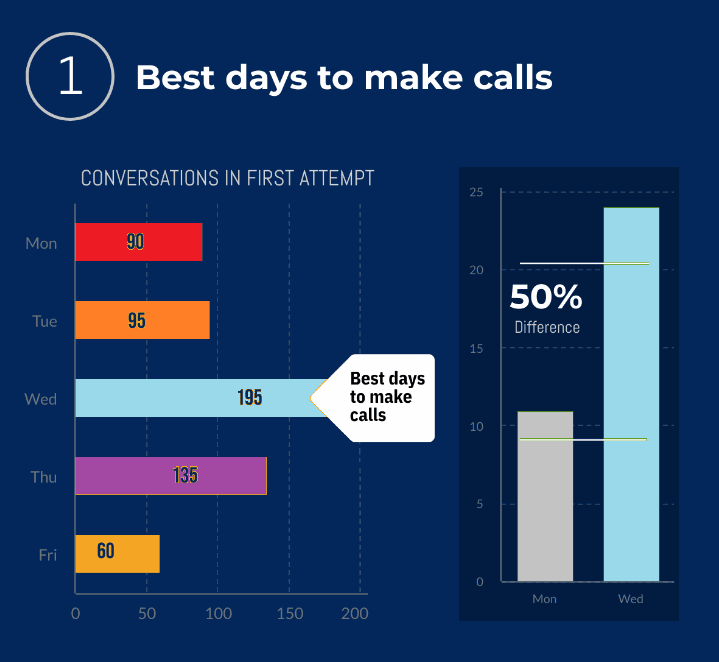
Image Source: CallHippo
Yesware conducted a study into the matter. It looked at 25,000+ calls and showed Tuesday and Thursday to have the most calls that lasted over five minutes. InsightSquared’s research determined Tuesday to have the best connect rate, which was 10%.
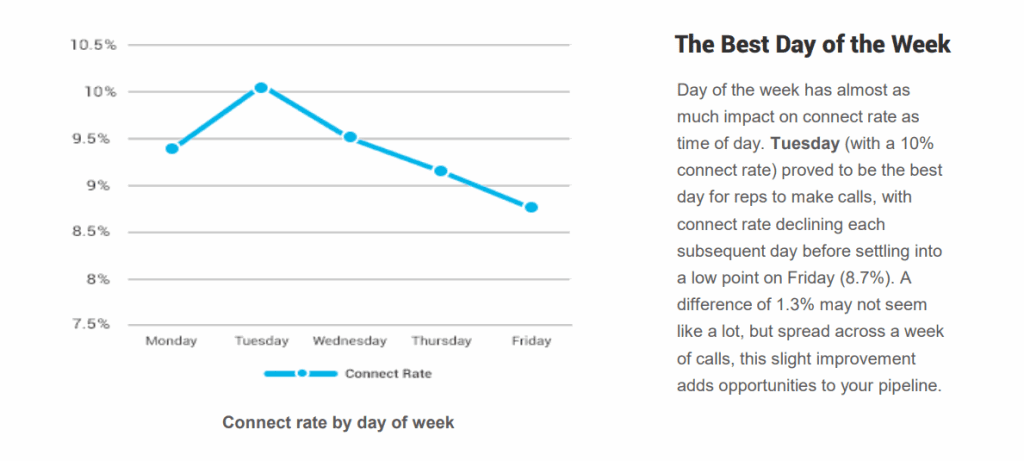
Image Source: InsightSquared
Lastly, InsideSales did a three-year study of over 100,000 call attempts. The results showed Thursday as the best-performing day of the week, and Wednesday was a close second.
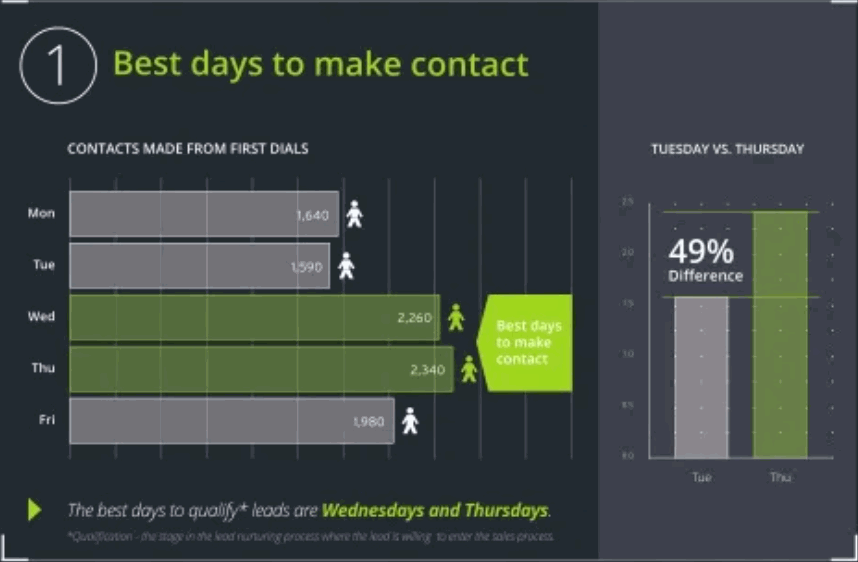
Image Source: InsideSales
If you summarize the results of all four studies, it looks like this:
- Wednesday for CallHippo
- Tuesday and Thursday for Yesware
- Tuesday for InsightSquared
- Thursday for InsideSales
The results are conclusive: Tuesday, Wednesday, and Thursday are the best days to call. Monday and Friday are too early and late in the working week, and the weekend is a no-go.
Regarding the hour of the day, it appears there are two ideal time windows to call. These are the late morning (10 AM to 12 PM) and late afternoon (2 PM to 5 PM). Research studies back this up. We’ve listed four of them below.
A CallHippo study found 4 PM to 5 PM as the best time to call, and 11 AM to 12 PM came second.
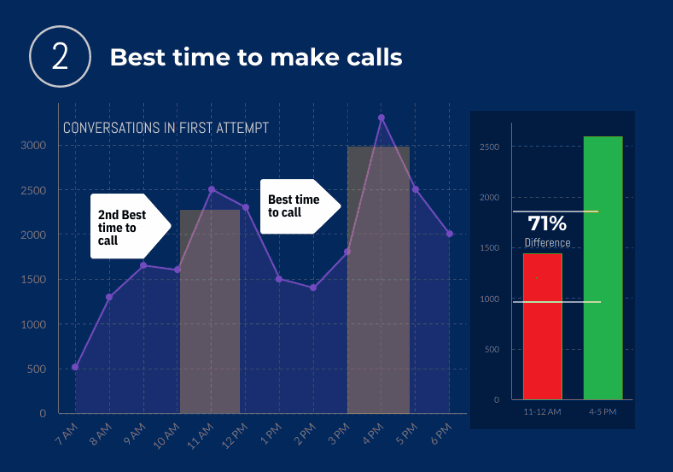
Image Source: CallHippo
Another study from InsightSquared found similar results. From 10 AM to 11 AM, the strongest connect rate remained strong until 4 PM. 10 AM to 4 PM was the time InsightSquared suggested was the best time to call. However, avoid lunchtime.
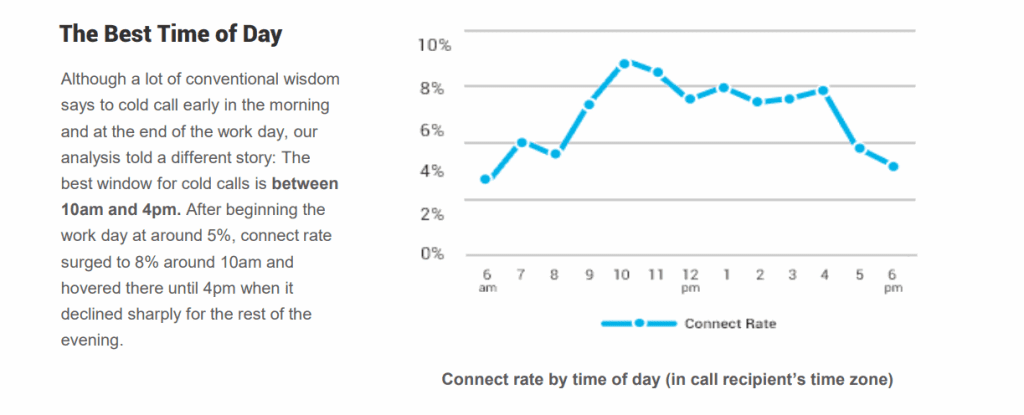
Image Source: InsightSquared
InsideSales’ three-year study found that 4 PM to 5 PM was the best time to call, followed by 8 AM.
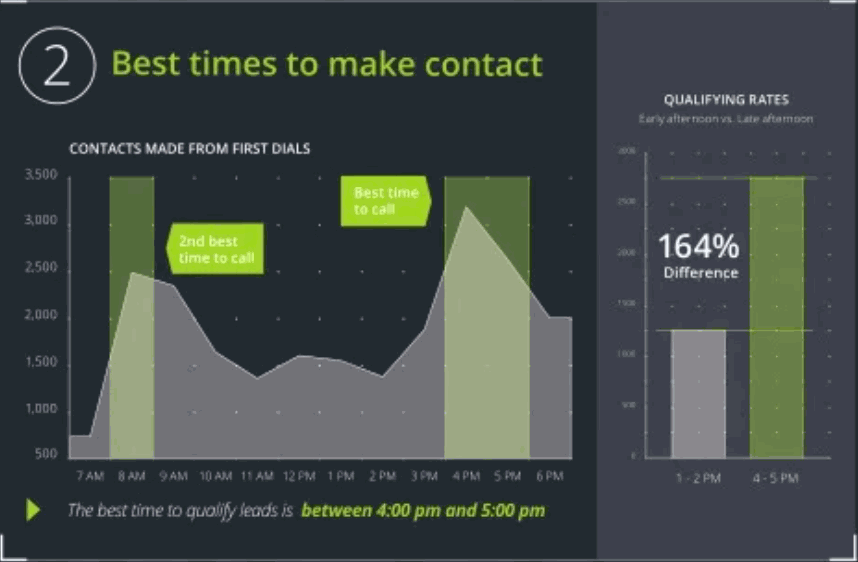
Image Source: InsideSales
Revenue.io’s study found 4 PM to 5 PM to have the best connect rates. 3 PM and 4 PM were second, and 5 PM to 6 PM was third.
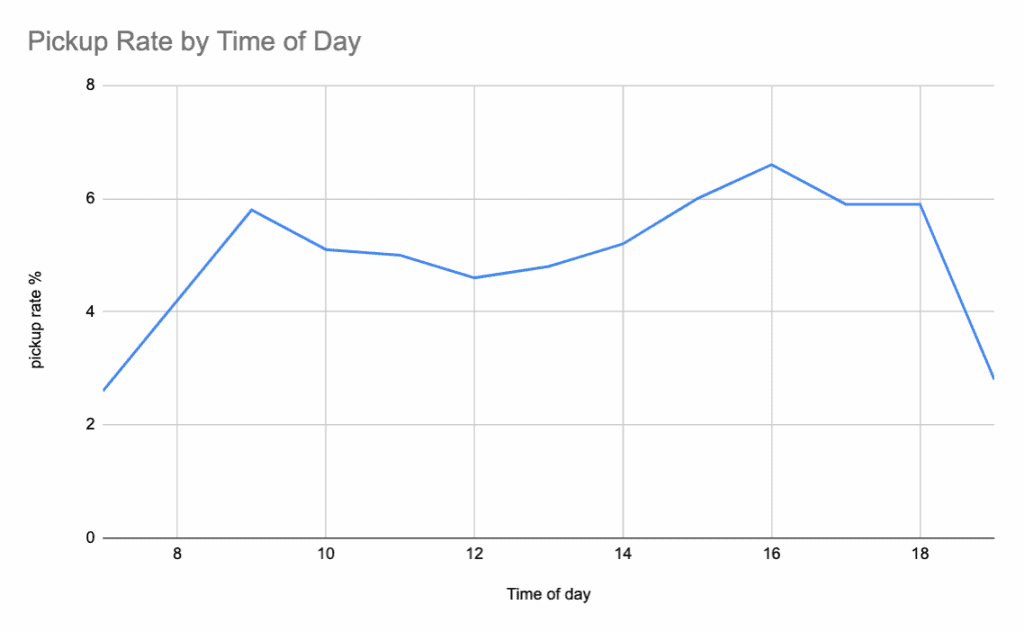
Image Source: Revenue.io
If you add all these four studies together, it looks like this:
- 4 PM to 5 PM for CallHippo
- 10 AM to 11 AM for InsightSquared
- 4 PM to 5 PM for InsideSales
- 4 PM to 5 PM for Revenue.io
The results confirm that the late morning and late afternoon periods have the best connect rates, making these the best times to call during the day.
When it comes to email, the results are somewhat similar. a HubSpot survey of over 300 email marketers found these time windows to be the best to send an email:
- 9 AM to 12 PM
- 12 PM to 3 PM
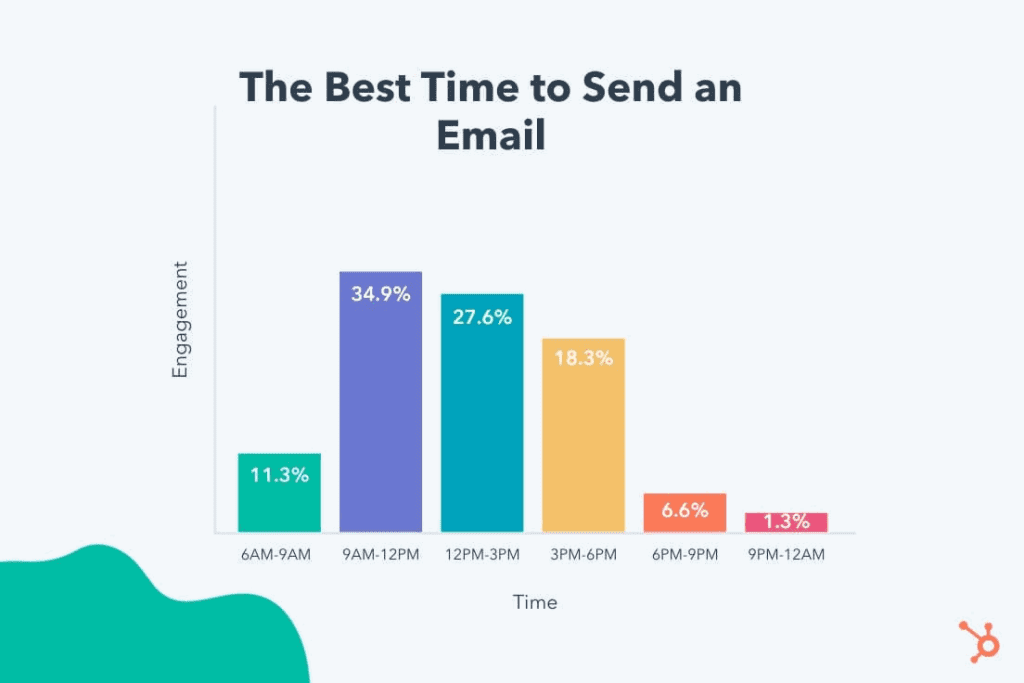
Image Source: HubSpot
The survey also looked at the best days of the week to send an email. The results showed the highest engagement on Monday, Tuesday, and Wednesday.
This is a lot of data, but what does it mean for cold calling and emailing? Generally speaking, avoid the weekend and before and after working hours. Also, avoid lunchtime. Each prospect is unique, so experiment and find your best time to do outreach.
Buyer Persona
Your buyer personas can influence the ideal method of communication. Specific buyers will prefer email over phone calls. It depends on several factors, including their age, their employment, the industry they work in, and more.
Zoomers and millennials prefer to communicate by email. If your cold outreach prospect is younger, consider this into the equation. Employees in customer-facing roles tend to favor the telephone as a large part of their job revolves around making and taking calls.
If they work in an internal position, email is probably their preference. The industry can also play a factor—traditional industries, such as manufacturing or construction, like phone calls.
Prospect Level
How high or low your prospect is within the hierarchy of their company matters. The higher they are, the more likely your call will be answered. It might not be them, as it could be an assistant. Either way, they’re more likely to respond to phone calls than lower employees.
We’d recommend using cold calling fatmthe anagement level and up. Leadership, c-suite, and heads of departments also tend to have more experience on the phone. This means that sales calls won’t intimidate them as much. They’ll be more relaxed and able to respond effectively.
The lower-ranking employees tend to be away from the office more. They’re traveling, so a communication channel like email would be ideal.
Essential Tools for Cold Outreach
To conduct cold outreach successfully, you’ll need some tools. We’ve listed three must-have tools below.
B2B Database
A B2B database is a cloud-based software that helps you uncover business email addresses, direct dials, and mobile numbers. It’s a tool you must have if doing cold outreach.
The best B2B database on the market today is UpLead. It has one of the best databases, with over 160 million B2B email addresses from over 200+ countries. It has 16+ million company profiles and has a 95% data accuracy guarantee.
UpLead has many capable features that simplify finding your prospects’ contact information. Search filters, firmographic data, and technology tracking allow you to sift through the database. You can easily find business email addresses, mobile numbers, and direct dials.
Email Provider
An email service provider (ESP) is necessary for those who want to run effective cold email outreach. Thanks to special features, these platforms allow you to conduct email marketing effectively.
For instance, you can use the bulk send functionality to email an extensive list of prospects. Analytics allow you to track the performance of your cold email campaigns, and you can use this information to optimize your approach.
Other valuable features include automation, audience segmentation, and list management. Some popular email service providers include:
- Mailchimp
- Aweber
- Constant Contact
- GetResponse
- ConvertKit
Business Number
If you intend to cold call, you’ll need a dedicated business number that you can use to reach prospects. You want to separate your private mobile number from your work-related telephone number. A business number allows you to do that.
Business phone numbers usually come with software provider platforms that give you advanced functionality. For instance, analytics features allow you to track the performance of your cold phone calls.
FAQs About Cold Calls vs. Cold Emails
Determining if you should cold call or email first depends on whom you’re targeting with your cold outreach campaign. Calling is more personal and is ideal if you need an immediate response. It’s more suited to things that require a big commitment, such as meetings and product trials. Cold emailing is better for minor issues, like referrals or asking to leave feedback. However, it all depends on who your prospects are and their industry.
Calling is better if you want an immediate response. However, emails allow you to add more information with attachments and links. Both are viable outreach methods and should be considered. The prospect you’re targeting will largely determine which to use.
If you’re contacting your prospect with a minor issue, emailing you would be ideal. Calling their phone might inconvenience them, especially if it’s not urgent and not a significant concern.
What You Need to Remember About Cold Calling vs. Cold Emailing
Cold calling and cold email are two capable outreach methods. With them, you can target prospects who have never interacted with your brand. This article covered everything you need to know about cold calling and cold emailing.
We looked at the basics of both outreach strategies, providing pros and cons. We also addressed deciding between the two and the three must-have tools. With this information, you should be able to successfully discover which outreach method is ideal for your needs


